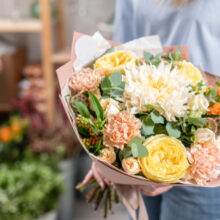 Flowers have captivated us for centuries with their beauty, fragrance, and symbolism. From simple wild blooms to intricate and carefully crafted arrangements, flowers hold a timeless allure that transcends cultures and historical periods. In this blog post, we will embark on a historic journey through time, unraveling the rich history and cultural significance of floral elegance.
Flowers have captivated us for centuries with their beauty, fragrance, and symbolism. From simple wild blooms to intricate and carefully crafted arrangements, flowers hold a timeless allure that transcends cultures and historical periods. In this blog post, we will embark on a historic journey through time, unraveling the rich history and cultural significance of floral elegance.
Ancient Beginnings: Floral Offerings and Decorations
The use of flowers in human society can be traced back to the earliest civilizations. In ancient Egypt, flowers played a vital role in religious rituals and funerary practices. Floral offerings were made to honor deities, while elaborate flower arrangements adorned the tombs of pharaohs, signaling a belief in the afterlife. Similarly, in ancient Greece and Rome, flowers were used in ceremonies and joyous celebrations. The art of flower garlands, wreaths, and crowns became prominent features in festivals and rituals, symbolizing honor and adoration.
The Renaissance of Floral Art: Conveying Emotions
During the Renaissance, floral art underwent a transformation, inspired by the renewed interest in aesthetics and naturalistic representations. Artists and poets alike found inspiration in the beauty of flowers, using them as symbols to convey deep emotions. Floral paintings emerged as a popular genre, showcasing elaborate bouquets and carefully arranged blooms. These works of art celebrated the harmony and delicacy of nature, revealing the profound connection between flowers and human emotions.
The Language of Flowers: Communicating Sentiments
In the 18th and 19th centuries, the language of flowers reached its peak of popularity. Inspired by the Victorian era’s fascination with symbolism and etiquette, flowers were given meaning and used to communicate various sentiments. Floriography, as it came to be known, allowed individuals to convey their feelings discreetly through the selection and arrangement of specific flowers. Each bloom carried its own symbolism, such as the red rose representing love and passion, or the white lily symbolizing purity and innocence. This intricate system of flower language served as a form of silent communication, giving individuals the ability to express their emotions without words.
The Rise of Floral Design: Aesthetic and Artistry
As floral arrangements evolved from mere adornments to art forms, the concept of floral design emerged. Flowers were no longer chosen solely for their symbolism but also for their aesthetic appeal and complementary colors. The study of floral design became an art form, with the arrangement of blooms guided by principles of balance, proportion, and harmony. This marked the beginning of floral design as a profession, with individuals specializing in creating stunning compositions for various occasions, from weddings to special events.
Influence of East Asian Culture: Ikebana and Beyond
While the Western world was shaping floral design, East Asian cultures had their own unique approaches to flower arrangements. In Japan, the art of Ikebana, or “living flowers,” developed as a disciplined practice that emphasized minimalism and the beauty of simplicity. Ikebana focused on creating natural and asymmetric compositions, employing a few carefully chosen flowers, branches, and leaves. This aesthetic philosophy had a profound impact on the global floral design scene, inspiring artists and designers to explore new techniques and appreciate the subtle elegance of East Asian floral art.
Modern Trends: Eclectic Styles and Sustainability
In the modern era, floral design has experienced a surge of creativity and innovation. Traditional styles continue to thrive, with the influence of historical aesthetics evident in many arrangements. However, recent trends have embraced a more eclectic approach, blending different styles, textures, and unexpected elements. Contemporary floral designs often incorporate unconventional materials like succulents, fruits, or even recycled objects, reflecting a growing emphasis on sustainability and ecological awareness.
Furthermore, floral installations and large-scale arrangements have become prominent features in art exhibitions and public spaces, pushing the boundaries and transforming flowers into immersive experiences. These modern trends demonstrate the ever-evolving nature of floral elegance, as artists and designers continue to reinvent and experiment with new possibilities.
Summary
Floral elegance, with its deep-rooted history and cultural significance, has captivated people around the world for centuries. From ancient offerings to Victorian symbolism and modern artistic expression, flowers have played a central role in our lives. As we journey through time, we witness how floral arrangements have evolved from mere decorations to profound expressions of emotions and artistry. The allure of flowers remains timeless, bridging gaps between cultures and generations, and continuing to inspire us with their beauty and symbolism. Whether in the form of a carefully crafted bouquet or a striking floral installation, flowers will always hold a special place in our hearts and minds.
Need a Florist in San Francisco, CA?
Since 1939, The Delicate Daisy – House of Flowers has been San Francisco’s premier locally owned and operated floral destination. Roxane Rockwell and her talented team have been crafting spectacular arrangements of fresh flowers and plants for all occasions and venues for over 31 years. From weddings, birthdays, and special events; to weekly corporate arrangements, local deliveries, and gourmet gift baskets, The Delicate Daisy – House of Flowers offers unparalleled experience, service, and quality. A landmark of the Richmond District of San Francisco, our charming retail space is open to the public, and is filled with beautiful flowers hand selected from the flower market three times a week by Roxane herself. Contact us today to learn more about what we can do for you!
